Using Art Therapy To Support Children With Autism
Unlocking Potential Through Creativity and Science
Children with autism spectrum disorder (ASD) often face unique challenges in communication, social interaction, and behavior. While Applied Behavior Analysis (ABA) has long been recognized as a scientifically validated approach to support these children, creative therapies, particularly art therapy, are gaining prominence for their complementary benefits. This article explores how art therapy supports children with autism, its therapeutic value alongside ABA, and the processes that optimize individualized treatment outcomes.
What is Applied Behavior Analysis (ABA) Therapy and Its Role in Autism Support?
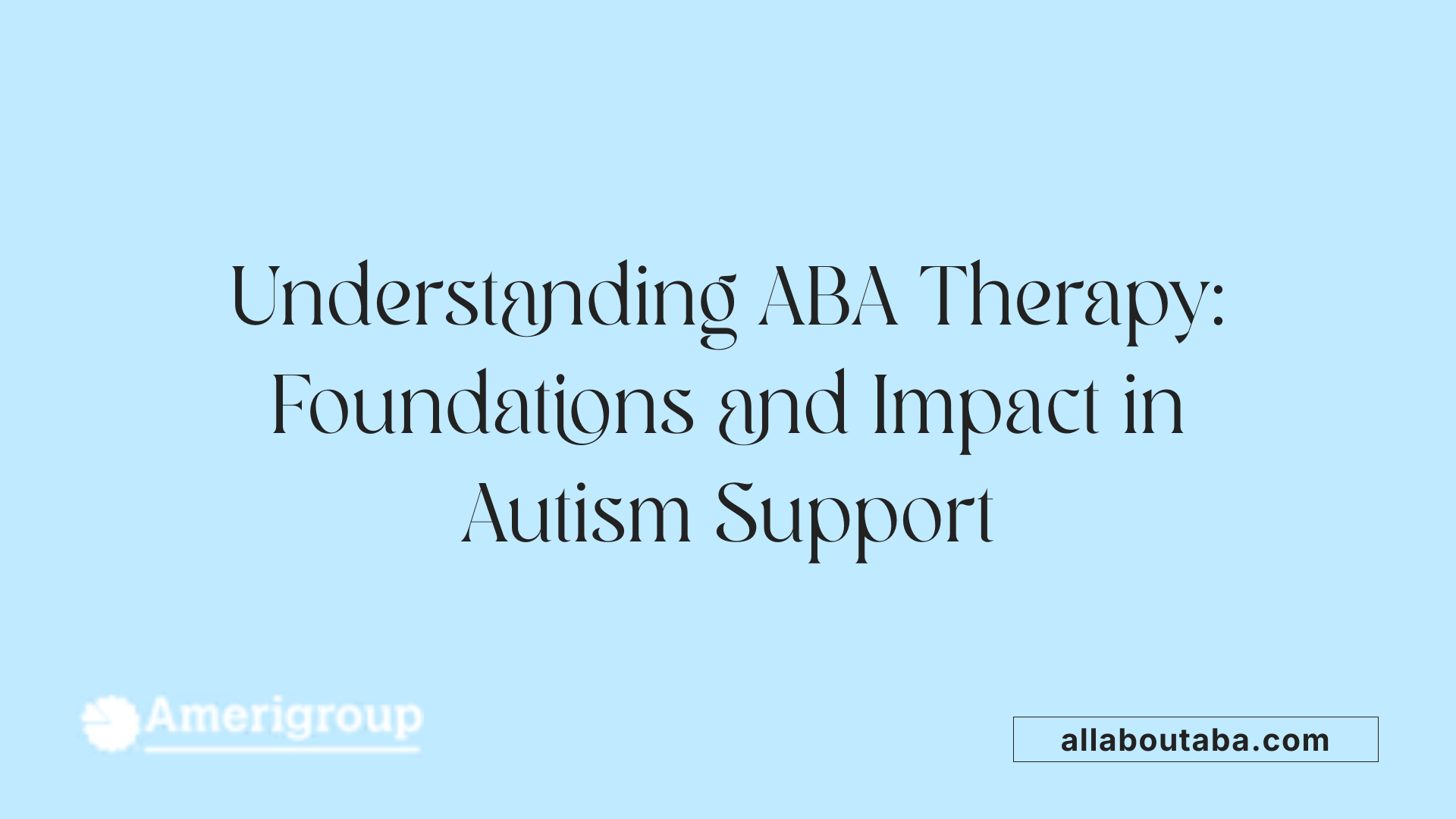
Definition and principles of ABA therapy
Applied Behavior Analysis (ABA) therapy is a science-based approach focused on understanding how behavior works and how the environment affects learning. It aims to increase helpful behaviors—like communication and social skills—and decrease harmful or learning-inhibiting behaviors. Central to ABA is analyzing behavior through the Antecedent-Behavior-Consequence (A-B-C) model to guide effective interventions.
Techniques used in ABA
ABA uses a variety of techniques such as positive reinforcement, where desired behaviors are rewarded to encourage repetition. It combines directed procedures and naturalistic learning opportunities to promote skills. Programs are personalized by qualified behavior analysts (BCBAs) who tailor goals and regularly assess progress using collected data.
Settings and flexibility of ABA
ABA therapy is highly flexible and individualized. It can be delivered across diverse settings including homes, schools, and community environments. This adaptability allows interventions to be contextually relevant, maximizing skill development and independence in everyday situations.
Goals and evidence supporting ABA effectiveness
The primary goals in ABA include improving communication, social interactions, self-care, play, motor abilities, and academics. Research supports that intensive, long-term ABA therapy (ranging from 25 to 40 hours weekly over 1–3 years) effectively enhances intellectual, language, social, and daily living skills. High-profile organizations like the US Surgeon General and American Psychological Association recognize ABA as an evidence-based best practice, making it a cornerstone of autism support services.
Who Provides ABA Therapy? Qualifications and Roles of Professionals
Types of ABA Professionals
ABA therapy is delivered by a spectrum of professionals with varying qualifications. The primary providers include Board Certified Behavior Analysts (BCBAs), Board Certified Assistant Behavior Analysts (BCaBAs), and Registered Behavior Technicians (RBTs). Additionally, some states require Licensed Behavior Analysts (LBAs) for independent clinical practice.
Educational and Certification Requirements
BCBAs possess advanced education, typically a master's degree in fields like psychology or child development. They complete postgraduate coursework, supervised practical experience, and pass a rigorous certification exam to earn their credential. BCaBAs typically hold bachelor's degrees, complemented by specialized coursework and supervised experience, and work under BCBA supervision. RBTs are paraprofessionals who undergo specific training, pass competency assessments, and provide one-on-one implementation of treatment plans under close supervision.
Roles of BCBAs and Other Staff
BCBAs design, oversee, and modify ABA programs by conducting assessments and setting individualized goals. BCaBAs assist in treatment delivery under BCBA guidance. RBTs execute daily interventions as outlined in the therapy plans, ensuring consistent implementation. LBAs, where required, may independently provide and supervise ABA services. Together, these professionals form a collaborative team dedicated to improving communication, social skills, and behavior in children with ASD.
Customizing ABA Therapy: Tailoring Interventions to Individual Needs
How does ABA therapy tailor interventions to meet the individual needs of people with autism?
ABA therapy begins with a thorough behavioral assessment conducted by a qualified behavior analyst (BCBA). This assessment highlights the unique strengths, challenges, and developmental goals of the individual with autism. Using this information, the BCBA crafts a personalized treatment plan targeting specific behavioral objectives such as communication, social skills, self-care, play, motor abilities, and academic performance.
The therapy employs evidence-based techniques including positive reinforcement—rewarding desired behaviors to encourage their recurrence—discrete trial training, and environmental modifications to foster meaningful learning and behavioral changes. A fundamental principle in ABA is understanding the antecedents, behaviors, and consequences (the A-B-Cs) to analyze and modify behavior effectively.
Behavioral objectives targeting communication, social and daily skills
The treatment goals in ABA are tailored to each person’s needs and aimed at increasing helpful behaviors while reducing behaviors that may hinder learning or safety. These goals often include improving verbal and non-verbal communication, enhancing social interaction, developing self-care and daily living skills, and supporting academic and motor skills development. Sessions may target attention, memory, perspective-taking, and other areas to promote greater independence and success in various environments.
Data-driven adjustments and family involvement
ABA therapy is highly flexible and responsive. Continuous data collection and ongoing progress monitoring are essential to evaluate the effectiveness of the interventions. When necessary, strategies are adjusted to better meet the evolving needs of the individual. Family participation is encouraged and often includes caregiver training, ensuring that therapeutic techniques are consistently applied at home, school, and community settings. This comprehensive approach helps facilitate generalization of skills and supports sustainable long-term outcomes.
| ABA Therapy Component | Description | Impact on Intervention |
|---|---|---|
| Behavioral Assessment | Identifies unique strengths and challenges | Personalized program design focused on individual needs |
| Positive Reinforcement | Rewards desired behaviors to encourage repetition | Increases helpful behaviors and improves learning outcomes |
| Goal Setting | Targets communication, social, daily living, and academic skills | Facilitates development of independence and functional skills |
| Data Collection and Monitoring | Tracks progress to adapt therapy plans | Ensures interventions remain effective and goal-oriented |
| Family Involvement | Training caregivers to reinforce therapy techniques | Promotes skill generalization and consistency across settings |
Therapeutic Goals and Outcomes in ABA for Autism
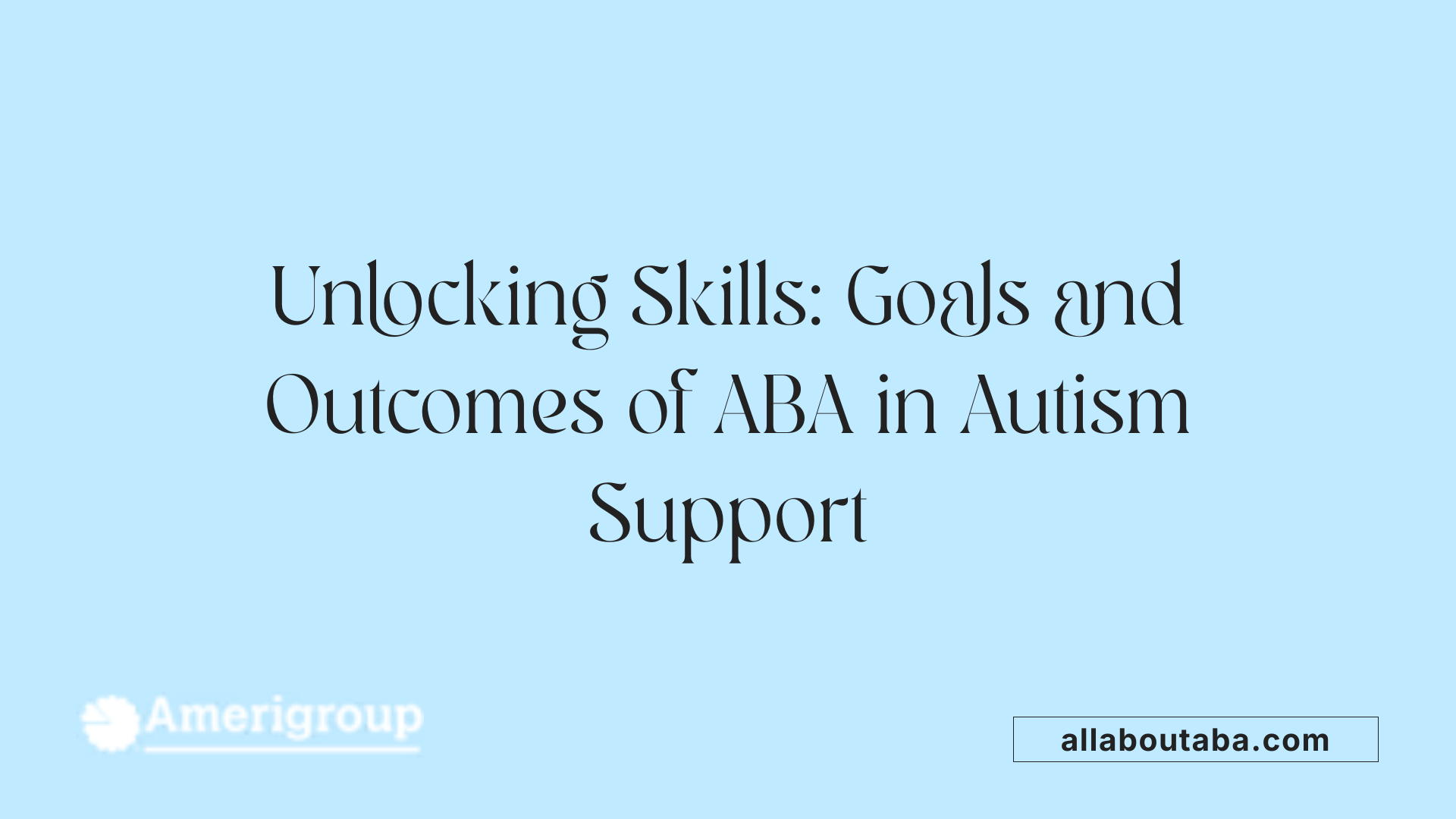
What are some common goals or outcomes targeted through ABA therapy for individuals with autism?
ABA therapy focuses on promoting a wide range of meaningful and individualized goals designed to improve the lives of individuals with autism. A primary target is enhancing communication skills, which includes both verbal expression and non-verbal methods such as gestures or use of communication devices. Improvements in social skills are another vital outcome, helping individuals better engage in social interactions and understand social cues.
Behavioral improvements are central to ABA, aiming to increase helpful behaviors while reducing those that interfere with learning or daily functioning. This may involve managing problem behaviors and fostering emotional regulation.
ABA also emphasizes developing independence in daily living activities, including self-care, play, and academic skills. These areas support the individual's capacity to succeed in various settings, from home to school and community environments.
Importantly, ABA goals are measurable and evidence-based. Therapists collect ongoing data to assess progress and modify intervention strategies as needed. Examples include teaching requesting skills, emotional understanding, and social play behaviors to support communication and social participation.
Overall, ABA therapy is designed to tailor interventions to individual needs, promoting skill acquisition, behavioral regulation, and greater independence for children with autism.
Evidence Supporting ABA Therapy Effectiveness for Autism
What evidence exists regarding the effectiveness of ABA therapy for improving behaviors in people with autism?
Scientific research provides substantial evidence supporting Applied Behavior Analysis (ABA) as an effective therapy for individuals with autism spectrum disorder (ASD). Meta-analyses and long-term studies affirm that ABA programs—particularly those that are intensive, early-start, and personalized—can significantly improve communication, social skills, attention, and daily living abilities.
In various studies, children with autism who underwent 25-40 hours per week of ABA therapy over one to three years showed marked progress in intellectual functioning, language skills, and social behaviors. For example, early intensive ABA interventions led to notable improvements in communication and reductions in disruptive or harmful behaviors. These outcomes are grounded in systematic data collection and ongoing assessment performed by qualified behavior analysts (BCBAs) who tailor programs to each individual's needs.
What skill improvements and behavior reductions have been observed?
ABA therapy aims to increase desirable behaviors while decreasing those that impede learning or social success. Improvements observed include:
- Enhanced language and verbal communication abilities
- Increased attention span and focus
- Better social engagement and interaction skills
- Greater memory and academic competence
- Decreased problem behaviors such as tantrums or self-injury
These gains are achieved through strategies like positive reinforcement—rewarding positive behaviors to encourage recurrence—and naturalistic learning opportunities that promote generalization of skills across environments.
What is the role of parental involvement and consistency in ABA therapy?
Parental involvement is crucial in maximizing ABA therapy outcomes. Consistency in implementing therapeutic techniques both at home and in other settings enhances skill acquisition and retention. Parents often receive training to reinforce behaviors, track progress, and collaborate with therapists.
Moreover, ABA programs emphasize flexible delivery across home, school, and community contexts, ensuring that the child encounters supportive learning environments daily. Regular data collection and progress evaluation enable continual adjustment of interventions, fostering steady development.
Together, rigorous scientific support, individualized programming, and active caregiver participation establish ABA as a cornerstone evidence-based approach for improving behaviors and functional skills in children with autism.
Introduction to Art Therapy for Children with Autism

What Is Art Therapy and What Purpose Does It Serve for Children with Autism?
Art therapy is a mental health practice that employs active art-making, the creative process, and therapeutic relationships to promote growth and healing. For children with autism spectrum disorder (ASD), it offers an expressive outlet to communicate, especially when verbal skills are limited. Under the guidance of master-level art therapists, these children engage in drawing, painting, and other creative activities tailored to their needs.
How Does Art Therapy Provide Sensory and Emotional Benefits?
Engaging in art offers multi-sensory experiences that are physically tangible and comforting, aiding sensory regulation. This stimulation helps children train their nervous systems, enhancing emotional regulation and sensory sensitivity. Moreover, creating art fosters self-esteem, independence, and a safe space to explore complex emotions that children with ASD might struggle to express otherwise. This process promotes self-awareness, self-confidence, and emotional health, critical for overall social functioning.
How Does Art Therapy Help Children with Limited Verbal Skills Express Themselves?
Art provides an indirect yet powerful form of communication for children who find verbal expression challenging. Through various modalities, children can convey thoughts and feelings nonverbally, improving social interactions and communication skills. Group art projects further encourage social engagement, boosting social and communication skills by promoting interactions with peers and therapists. This helps children express emotions and ideas without relying solely on speech, ultimately supporting their developmental growth.
Art Therapy Techniques and Their Impact on Social and Emotional Development
How Are Drawing, Painting, Music, and Theater Used in Art Therapy for Children with ASD?
Art therapy employs diverse creative activities such as drawing, painting, music, and theater to support children with Autism Spectrum Disorder (ASD). Drawing and painting serve as nonverbal methods for children to express thoughts and emotions when verbal communication is limited. Music interventions enhance verbal communication, social awareness, eye gaze, and perspective-taking, encouraging greater engagement. Theater-based approaches, notably the Social Emotional NeuroScience Endocrinology (SENSE) method, focus on improving social cognition and interactive communication skills.
How Does Art Therapy Enhance Communication and Social Skills?
Art therapy fosters communication and social interaction by providing indirect expression channels and structured group activities. Collaborative art projects improve social skills like eye contact, verbal interaction, and cooperative behavior. Facilitating shared creative experiences allows children to build self-esteem and practice positive social engagement in supportive settings. Music and theater increase opportunities for turn-taking, perspective understanding, and emotional sharing, all crucial for interpersonal development.
In What Ways Does Art Therapy Support Emotional Regulation and Sensory Integration?
Art-making offers multi-sensory stimulation that helps children with ASD regulate their emotions and sensory responses. The physical and tangible nature of art materials creates a comforting sensory environment, aiding in reducing anxiety and improving focus. Emotionally expressive art activities allow exploration and management of feelings in a safe space. Using various textures, colors, and sounds helps train the nervous system, improving sensory sensitivity and processing challenges common in ASD.
| Art Therapy Modality | Main Benefits | Role in ASD Support |
|---|---|---|
| Drawing & Painting | Nonverbal expression, fine motor skills, emotional exploration | Enhances communication, self-esteem, and sensory regulation |
| Music | Verbal communication, social engagement, eye gaze | Boosts social awareness and interactive participation |
| Theater (SENSE) | Social cognition, communication, social skills | Advances perspective-taking and interaction abilities |
This blend of creative therapies provides children with ASD valuable tools to develop social, emotional, and behavioral capacities critical to their daily lives and overall development.
Synergy Between Art Therapy and ABA: Complementary Benefits
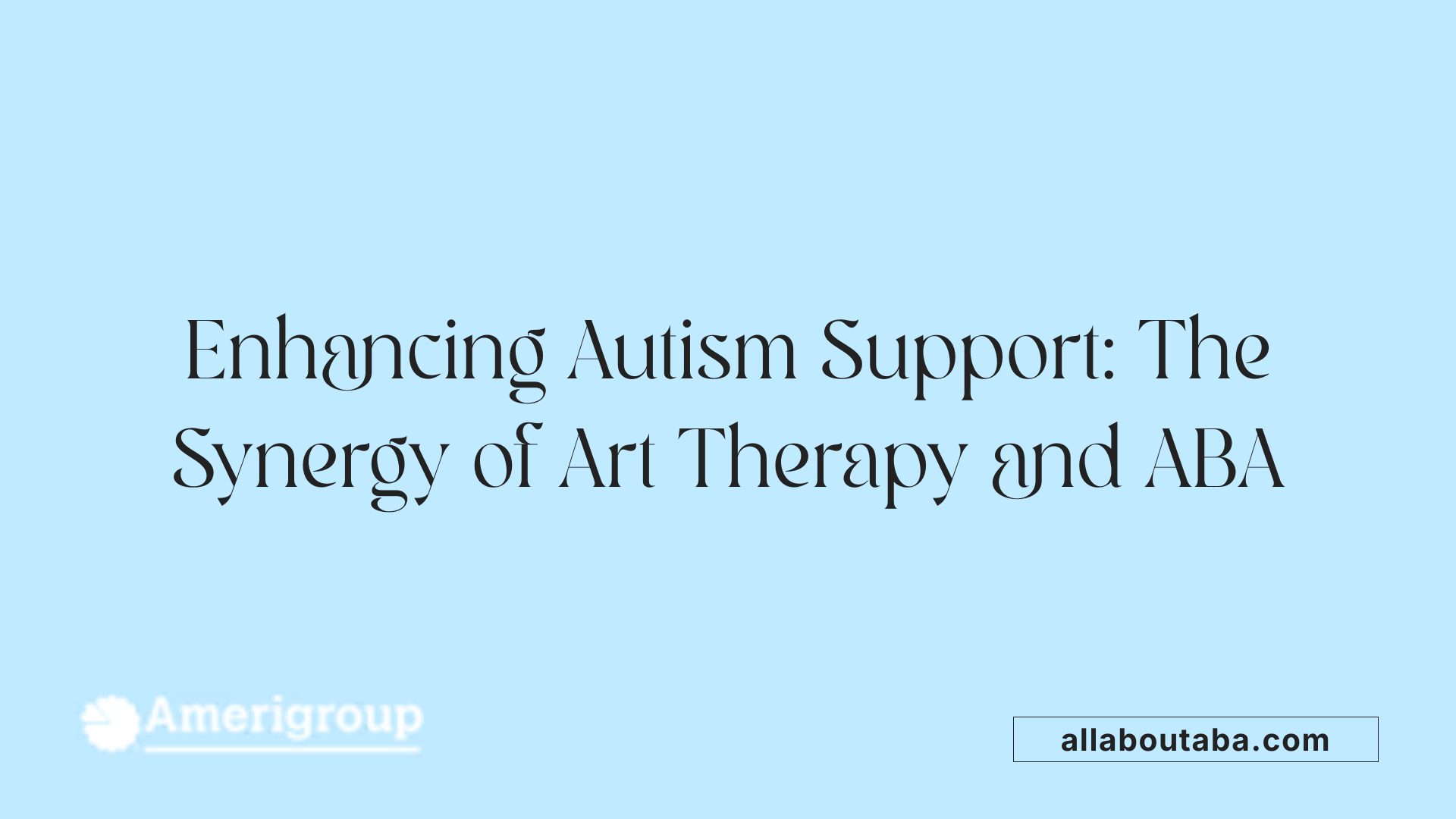
How Does Combining Art Therapy With ABA Enhance Treatment for Children with ASD?
Combining art therapy with Applied Behavior Analysis (ABA) creates a powerful blend of therapeutic approaches tailored to the unique needs of children with Autism Spectrum Disorder (ASD). While ABA is grounded in behavior science to increase helpful behaviors and decrease harmful ones via reinforcement techniques, art therapy offers a creative, sensory-rich outlet that encourages expression, emotional exploration, and communication.
This combination leverages the strengths of both therapies. Art therapy introduces antecedent-based interventions (ABIs), which involve strategically modifying environmental stimuli before behaviors occur. This approach fits well with ABA’s focus on understanding antecedents and consequences to shape behavior. Through creative expression, children experience stimulus changes that can decrease anxiety, increase engagement, and reduce undesirable behaviors, making reinforcement more effective.
What Role Do Antecedent-Based Interventions Play?
Antecedent-based interventions are an important facet of ABA and when integrated with art therapy, they provide a non-verbal, engaging way to influence behavior. For example, offering art activities as a preferred stimulus before challenging tasks can enhance attention, reduce resistance, and support smoother transitions. This anticipatory method complements ABA’s use of positive reinforcement by creating a favorable environment for learning and behavior change.
How Does Creative Expression Facilitate Behavior Modification?
Creative arts provide children with ASD a unique channel to express thoughts and feelings that may be difficult to verbalize. Art-making activities like drawing, painting, or music enable self-expression, emotional regulation, and improve communication skills, which are all behaviorally relevant outcomes.
Moreover, art therapy activities promote motor skills and sensory processing, crucial client factors in occupational therapy. As children engage in creative processes, ABA therapists can observe and reinforce positive behaviors such as sustained attention, task completion, eye contact, and social interactions. This ongoing observation and reward system encourages the repetition of beneficial behaviors in naturalistic settings.
Research supports these synergistic effects: studies have documented increased attention spans, improved social engagement, and greater ability to follow instructions after consistent art therapy sessions combined with ABA techniques. Group art sessions enhance social skills and self-esteem while individual ABA sessions provide structured behavior support.
By integrating these therapies, treatment plans can be more flexible, holistic, and responsive to individual needs, fostering independence and improving overall quality of life for children with ASD.
Practical Considerations: Implementing Art Therapy for Children with Autism
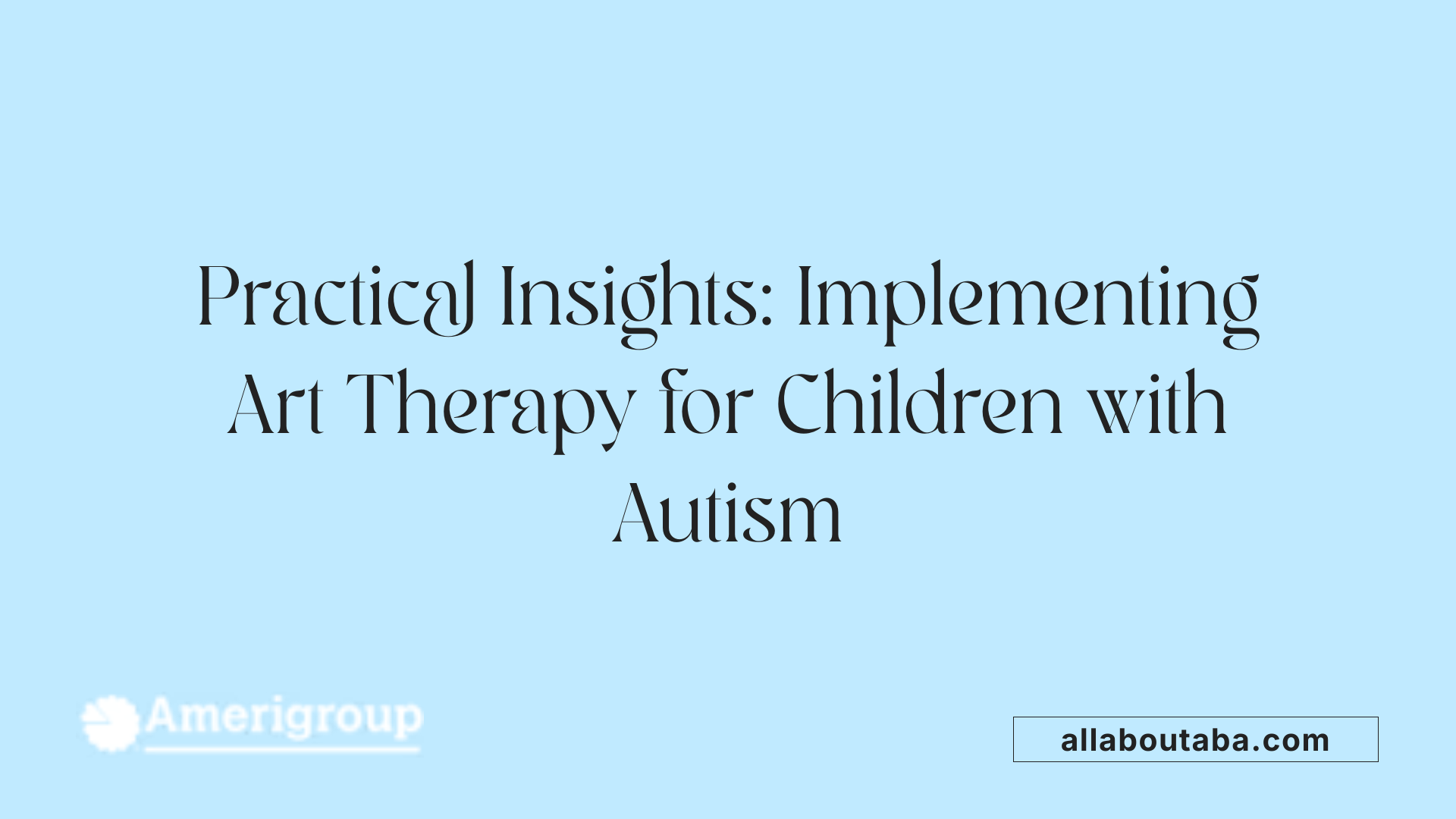
Group vs Individual Art Sessions
Art therapy for children with autism can be effectively delivered in both group and individual settings. Individual sessions allow personalized attention tailored to a child's unique needs, fostering self-expression and emotional regulation through tailored activities like drawing and painting. Meanwhile, group art sessions encourage social interaction, improving eye contact, verbal communication, and cooperation among peers. These group activities enhance social skills and self-esteem, providing a supportive environment that complements other therapies such as ABA.
Role of Parents and Caregivers
Parents and caregivers play a crucial role in maximizing art therapy benefits. Engaging in art activities together strengthens the parent-child bond, promotes understanding, and helps reinforce skills developed during therapy. Their involvement also provides emotional support, encourages practice outside sessions, and helps create a safe environment for children to explore creative expression and communication.
Use of Art Therapy Within Multidisciplinary Teams
Incorporating art therapy into a multidisciplinary treatment approach enhances overall outcomes for children with ASD. Collaboration with occupational therapists, speech therapists, behavioral analysts, and educators ensures comprehensive care addressing social, emotional, sensory, and communication challenges. This integration supports holistic development and maximizes the efficacy of each intervention modality.
Measuring Progress and Outcomes
Assessing progress in art therapy involves observing improvements in emotional expression, social interactions, and motor skills. Therapists use structured environments and visual supports tailored to each child’s needs, tracking enhancements in attention span, ability to follow instructions, and reduction in behavioral problems. Documentation of these outcomes, combined with feedback from parents and other team members, guides ongoing therapy adjustments and goal setting to ensure continued growth and independence.
Building Bonds and Enhancing Quality of Life Through Art
How do parent-child relational art activities strengthen bonds?
Engaging in art activities offers parents and children with ASD a unique opportunity to connect. Creating art together fosters understanding and acceptance in a relaxed environment, deepening emotional ties. This relational artmaking promotes secure attachment, helping parents better appreciate their child’s feelings and perspectives.
In what ways does art therapy promote self-esteem and independence?
Art therapy encourages children with autism to experience a sense of achievement through tangible creations. Successfully completing art projects builds confidence and nurtures independence. This creative outlet offers a safe space for self-expression, which contributes significantly to developing a positive self-image.
How does art therapy facilitate nonverbal communication and social interaction?
Many children with ASD have limited vocabulary; art therapy provides alternative means of expression through drawing, painting, or other modalities. Collaborative art projects foster social interaction by encouraging communication, cooperation, and interaction with peers and therapists. This helps develop essential social skills in a supportive setting.
What overall improvements in behavior and cognitive skills have been observed?
Art therapy supports emotional regulation by creating a safe space for exploring feelings, which is crucial for children facing sensory processing challenges. Studies show improvements in attention span, ability to follow instructions, and reductions in behavioral problems after multiple art sessions. Furthermore, group art activities enhance eye contact, verbal skills, and task engagement, thereby contributing to better cognitive and behavioral outcomes.
By integrating art therapy into treatment plans, families can experience strengthened relationships and children can enjoy enriched emotional, social, and cognitive development.
Art Therapy: A Valuable Complement to ABA in Autism Support
Art therapy provides a powerful, creative avenue for children with autism to express emotions, develop communication skills, and regulate sensory experiences. When integrated with evidence-based approaches like Applied Behavior Analysis, art therapy enriches personalized treatment plans and broadens therapeutic possibilities. Through multisensory engagement and supportive relational connections, art therapy fosters improved social skills, self-esteem, and independence. As research continues to validate these benefits, incorporating art therapy within multidisciplinary teams offers a more holistic and effective path to enhancing the quality of life for children with autism and their families.
References
- Art Interventions for Children With Autism Spectrum Disorder
- Applied Behavior Analysis (ABA)
- Art Therapy for Autism: 8 Incredible Benefits!
- Art Therapy as a tool to Enhance Social Skills in Children with ...
- Benefits of Art Therapy for Children with Autism
- The effectiveness of applied behavior analysis program ...
- The Controversy Around ABA
- Applied Behavior Analysis (ABA)
- 6 Benefits of ABA Therapy for Children with Autism
- Applied Behavior Analysis (ABA)
Other articles
Recent articles

The Role Of Teachers In Fostering Autism Peer Acceptance

Using Art Therapy To Support Children With Autism

Autism And Strategies For Addressing Sensory Defensiveness

Autism And The Benefits Of Structured Leisure Activities

How To Support Autistic Students During Exam Season

Autism And Goal Setting For Personal Growth

How To Use Gamification In Autism Learning Programs

How Schools Can Reduce Bullying Of Autistic Students

Early Intervention Strategies For Autism Spectrum Disorder

The Role Of Therapists In Autism Life Skills Coaching

How To Support Autistic Individuals In Crisis Situations

Autism And Self-Care Routines For Stress Management

Understanding Echolalia And Its Role In Autism Communication

Autism And Fine Arts Education Benefits

The Impact Of Multisensory Learning On Autism Education

How Family Counseling Supports Autism Household Dynamics

Best Practices For Inclusive Playgrounds For Autism

Best Practices For Autism-Friendly Shopping Centers

How Autism Affects Fine Motor Skill Development

Best Ways To Introduce Sensory Activities Into Daily Routines

How Sports Teams Can Be Inclusive Of Autistic Players

Autism And Strategies For Building Workplace Resilience

Autism And The Impact Of Hormonal Changes During Puberty

How To Support Autistic Students In Foreign Language Classes

Best Ways To Teach Money Skills To Teens With Autism

Supporting Siblings Of Children With Autism

Autism And Co-Occurring Gastrointestinal Disorders

The Role Of Art Projects In Autism Sensory Integration

How Schools Can Incorporate Sensory Break Spaces

Best Practices For Autism Sensory Regulation At School

Autism And Strategies For Teaching Organizational Skills

Understanding The Relationship Between Autism And Anxiety Disorders

Autism And Life Planning For Long-Term Care

Exploring Visual Supports In Autism Education

Ways To Encourage Social Interaction In Children With Autism

The Connection Between Autism And Dyscalculia

The Role Of Occupational Therapy In Transition Planning For Autism

The Role Of Physical Therapists In Autism Motor Skills Support

How To Teach Decision-Making Skills To Autistic Young Adults

The Connection Between Autism And Epilepsy

Best Practices For Transitioning Autistic Children Into New Schools

Autism And Time Management Challenges In Adulthood

The Role Of Visual Arts In Autism Communication Development

How To Address Tactile Defensiveness In Autism

Best Practices For Telehealth Autism Therapy

How To Help Autistic Children Develop Friendship Skills

How Schools Can Support Autistic Students In Career Prep

Best Strategies For Autism-Friendly Event Planning

Understanding Noncontingent Reinforcement In Autism Behavior Plans

How Drama Therapy Benefits Autistic Individuals

Best Practices For Autism-Friendly Fitness And Recreation Centers

Best Ways To Promote Healthy Social Media Use For Autistic Teens

How To Help Autistic Children Cope With Public Speaking

Autism And Strategies For Managing Unexpected Changes

Best Podcasts About Autism For Parents And Educators

Autism And The Impact Of Seasonal Changes On Behavior

The Role Of Diet In Managing Co-Occurring Conditions With Autism

Sleep Challenges In Autism And Practical Solutions

Best Ways To Build Daily Routines For Autistic Children

Best Practices For Supporting Autistic Entrepreneurs

Autism And Strategies For Navigating Large Social Gatherings

Adaptive Sports And Recreational Activities For People With Autism

Autism And The Benefits Of Story-Based Learning Activities

Understanding The Role Of Play In Autism Development

Autism And The Impact Of Environmental Noise On Learning

How To Create Autism-Friendly Community Spaces

Autism And Chronic Health Conditions: What To Know

The Role Of Care Managers In Autism Life Planning

How To Teach Social Boundaries To Autistic Children

How Autistic Individuals Experience Empathy Differently

How To Support Autistic Employees In Remote Work Settings

Autism And The Relationship Between Motor Skills And Learning

How To Create Community Resource Guides For Autism Families

How To Teach Daily Living Skills To Autistic Teens

Autism And The Impact Of Mind-Body Practices On Stress Reduction

Autism And The Benefits Of Outdoor Group Activities

How To Create Autism-Friendly Sensory Paths In Schools

Best Practices For Autism-Friendly Park And Recreation Areas

Autism And Strategies For Reducing School Refusal

Supporting Autistic Individuals In Public Speaking

The Role Of Diet In Managing Autism Symptoms

The Benefits Of Gardening Clubs For Autism Social Development

How To Prepare Autistic Children For Dental Visits

Autism And Employment: Career Paths That Work

Best Practices For Autism-Friendly Hotels And Lodging

The Impact Of Screen Time On Autism Development

Autism Screening Tools For Early Childhood

The Role Of Physical Exercise In Autism Therapy

Best Strategies For Supporting Autistic College Students

The Role Of Technology In Autism Early Detection

Sensory-Friendly Classroom Design Ideas For Autistic Students

The Role Of Speech Therapy In Building Social Communication Skills

Best Strategies For Handling Autistic Burnout In Adults

Autism And The Importance Of Predictability In Routine
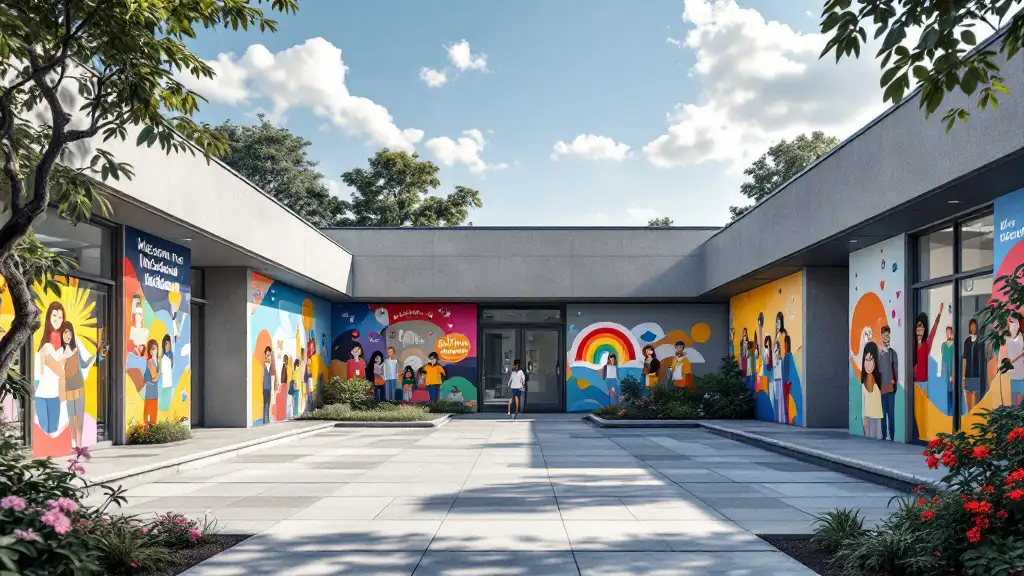
Autism And Peer Education: Teaching Acceptance In Schools

Best Practices For Sensory-Friendly Libraries And Reading Rooms

Self-Advocacy Skills For Autistic Adults

The Role Of Technology In Autism Peer Communication

Promoting Physical Activity In Children With Autism

How To Prepare Autistic Children For Medical Procedures
We’re All About You, Your Family, and Your Child

